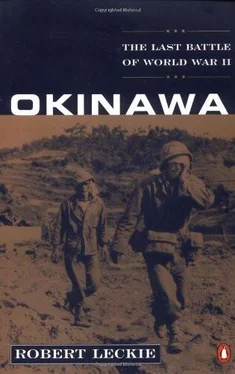Such reports helped to discourage the troops of the Thirty-second Army, and one private wrote in his diary: “The enemy is brazenly planning to destroy completely every last ship, cut our supply lines and attack us.”
He was absolutely correct, and “the enemy” by then was also hurling neutralizing thunderbolts at the homeland.
Throughout February and March, while the Marines were conquering Iwo Jima, land-and carrier-based planes struck again and again at the Great Loo Choo. Superforts began to rage all over the Ryukyus. Okinawa was effectively cut off from Kyushu in the north, Formosa in the south. On March 1, while the Fast Carrier Forces were returning to Ulithi from their third strike at Japan, there were so many planes strafing, bombing, and rocketing Okinawa that pilots had to get in line for a crack at a target. Lieutenant General Mitsuru Ushijima was impressed.
“You cannot regard the enemy as on a par with you,” he told his men. “You must realize that material power usually overcomes spiritual power in the present war. The enemy is clearly our superior in machines. Do not depend on your spirits overcoming this enemy. Devise combat method [ sic ] based on mathematical precision—then think about displaying your spiritual power.”
Ushijima’s order was perhaps the most honest issued by a Japanese commander throughout the war. It was Bushido revised, turned upside down and inside out—but the revision had been made too late.
First Blood for America
CHAPTER FIVE
In early October 1944—little more than a week after the crucial San Francisco conference—Fleet Admiral Bull Halsey’s monster Task Force Thirty-eight was speeding blacked-out through the Pacific night, bound northwestward for the opening salvos of the Okinawa campaign. When dawn broke it revealed a splendid and thrilling spectacle: seventeen aircraft carriers carrying one thousand aircraft, six fast battleships, fourteen cruisers, and fifty-eight destroyers together with the subsidiary ships such as oilers and tenders plunging through a white-capped gray sea almost at flank speed, some of them with “a bone in their teeth”—white bow waves curving away from either side of their prows—a huge and terrifying force to any Japanese unfortunate enough to witness their approach. Actually, Halsey’s fleet alone was more powerful than the entire battle force deployed by Admiral Nimitz at Midway on June 6, 1942, to defeat Admiral Isoroku Yamamoto’s Combined Fleet, thus restoring carrier power in the Pacific to par with five apiece and—more important—turning the tide of naval battle against Japan.
Halsey’s TF 38 was so large that it was spread out into four separate groups, each a task force in itself with a rear admiral in command. The precious carriers, as always, sailed in the center of each group in boxlike formation, with the battleships and cruisers steaming at the quarters, their protective antiaircraft guns raised like spikes fingering the sky. Around each formation sped the circling destroyers, seagoing sheep dogs snapping at the heels of their flocks, but actually screening them and searching, searching, searching for enemy submarines.
On all ships, surface and air radars rotated unceasingly, feeding information to their Combat Information Centers, each vessel’s nerve center where sailors worked silently in darkened compartments below. On the bridges or in sea cabins immediately adjacent to them stood the ship captains and task group commanders, tense and with furrowed brows anticipating—while dreading—those sudden emergencies that arise swiftly and require instant reaction. Throughout TF 38 hundreds of men perched high on the crow’s nests of masts swept the sea with binoculars, looking for those telltale tips of periscopes cutting through the water, and thus supplementing the electrical impulses of the radar or the pinging of the sonar sniffing out strangers submerged beneath the waves.
Day after day as the carriers penetrated deeper and deeper into enemy waters, they were turned into the wind to launch planes, either for antisubmarine or defensive fighter patrols. As they were catapulted into the air, the destroyers on pilot-rescue duty churned closer to either side of the flattops. It was the “tin cans’ ” duty to rescue crashed pilots. Aboard these slender long “black-water ships,” always a thrilling sight with their sterns dug into the water and their prows high, sometimes even bouncing on the waves, throwing up huge plumes of white spray, the deck officers kept a worried eye on the carriers’ deck angle. If a flattop in a changing wind turned suddenly to keep it on its bow, the destroyer might ram the carrier. To prevent such disaster, deck officers—usually young and highly responsible sailors—were carefully screened and trained.
Each carrier had a dual organization, its regular crew that sailed or fought the ship and its air group. The air group maintained and flew the planes: about eighty in the big Essex class twenty-seven-thousand-ton flattops, forty in the smaller Independence class, a carrier with flight decks mounted on a cruiser’s hull. With Vice Admiral Marc Mitscher in tactical command, TF 38’s airplanes—those peerless Curtiss Helldiver dive-bombers and Grumman Avenger torpedo planes, Grumman Hellcat fighter-bombers and fighters—would scourge Okinawa land and sea, especially the enemy island’s three operational airfields as well as the one on little Ie Island off Okinawa’s midwestern shore. All facilities—runways, barracks, warehouses, hangars, AA (antiaircraft) defenses, parked planes—would be blasted. Perhaps just as important, camera planes would take mosaic strip photographs of the island for map-makers back in Hawaii.
Before dawn of October 10, 1944, while intelligence officers briefed air crews on Okinawa’s defenses, all seventeen of the flattops made ready for battle. Elevators brought planes topside to be stationed in rows on teakwood decks awaiting launch or takeoff. Below, armorers armed the planes with bombs, five-inch rockets, twenty-one-inch torpedoes, or belts of .50 caliber machine-gun ammunition. At dawn pilot-rescue destroyers took station. With an ear-piercing swooosh! bow catapults hurled aloft those planes that needed artificial momentum while others roared down the deck to become airborne themselves.
Between daybreak and dusk the American airmen flew 1,396 sorties over Okinawa, dropping more than five hundred tons of bombs, destroying suicide submarines, flaming enemy fighters, sinking a tender, smaller ships, and the power-driven fishing boats in Naha harbor, while setting that city of sixty-five thousand persons ablaze. In all, ten transports and thirty merchant ships went to the bottom, along with half of the power-driven fishing boats and sixteen smaller warships—a serious loss of Okinawa’s patrol boats and trawlers assigned to supplying the island.
Perhaps more serious were the attacks on Naha warehouses, where three hundred thousand sacks of rice—enough to feed the Thirty-second Army for a month—were burned, plus the loss of five million rounds of rifle and machine-gun ammunition, ten thousand rounds of light artillery and mortar shells, and four hundred rounds of 47 mm antitank ammunition. The exact number of enemy planes destroyed or damaged was not known. One Japanese general was killed and another wounded, while military deaths totaled two hundred. Among civilians five hundred persons died—a tragic loss, even though unintended. Eventually, however, the Okinawans would understand that the safest place for them during such attacks—which they called “typhoons of steel”—was within Okinawa’s numerous caves, which sheltered them during the real typhoons that scourged the island. Perhaps even more important than the damage dealt to Ushijima’s installations were the thousands of aerial photographs taken, which, with others shot earlier by B-29s flying from China, enabled the American map-makers in Hawaii to produce a fairly accurate 1:24,000-scale map of utmost value to both infantry and artillery.
Читать дальше










